Add this eBook to your basket to receive access to all 87 records. Our indexes include entries for the spelling toomey. In the period you have requested, we have the following 87 records (displaying 21 to 30): These sample scans are from the original record. You will get scans of the full pages or articles where the surname you searched for has been found. Your web browser may prevent the sample windows from opening; in this case please change your browser settings to allow pop-up windows from this site.  Outstanding soldiers of the 21st regiment of Foot
(1860-1870) Outstanding soldiers of the 21st regiment of Foot
(1860-1870)
The 21st Regiment of Foot (The Royal North British Fusiliers) was in two battalions. The 1st battalion moved from Malta to the West Indies in 1860, returning to England in 1864, to Scotland in 1865, and to Birr in 1866: the depot was at Birr. In 1869 the battalion was moved to India. The second battalion was re-formed in Scotland in 1857; moved to England in 1858, and was at Aldershot in 1860: in 1862 it embarked for Ireland, and in 1863 was sent to India. Each year just a handful of outstanding soldiers of the regiment were chosen for good conduct medals and gratuities: these are listed here. There were two lists, one for men recommended for the Good Conduct Medal without a gratuity, and one for gratuities - £5 to a private, £10 to a corporal, and £15 to a serjeant. Both lists are indexed here, and each gives rank, name, regimental number, date of recommendation and date of issue. (The sample scan is from the 105th foot) | Sample scan, click to enlarge
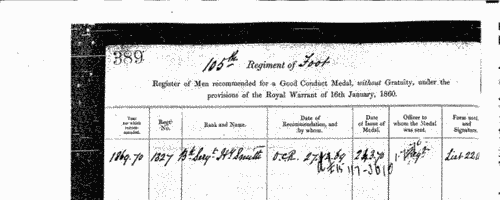
|  Men of the 40th Regiment who fought in the New Zealand War
(1863-1870) Men of the 40th Regiment who fought in the New Zealand War
(1863-1870)
New Zealand War Medal roll for the 40th (2nd Somersetshire) Regiment of Foot: for service in the New Zealand campaign 1863 to 1866: the rolls were compiled following a general order in 1869 and the medals were distributed in 1870. The regiment, although called the 2nd Somersets, was based at Birr in Offaly. It embarked for New South Wales 14 July 1852, and was moved to New Zealand in 1860; the men returned to England in 1866, and thence back to Ireland in 1869. | Sample scan, click to enlarge

|  Men of the Royal Irish regiment who fought in the New Zealand War
(1863-1870) Men of the Royal Irish regiment who fought in the New Zealand War
(1863-1870)
New Zealand War Medal roll for the 2nd battalion, the 18th (Royal Irish) Regiment of Foot: for service in the New Zealand campaign 1863 to 1867: the rolls were compiled following a general order in 1869 and the medals were distributed in 1870. | Sample scan, click to enlarge

| Infants in Tipperary Workhouse
(1873)
Return, “with Christian and Surname of each, of Infants Born in Irish Workhouses, or Admitted thereto when Healthy under Twelve Months Old, and attempted to be Reared therein during the Years 1872 to 1874, showing what has since become of them”. The returns from each poor law union workhouse give: Christian and Surname of Infant Born in the Workhouse, or Admitted Healthy, under Twelve Months; Year; and whether discharged, healthy, in hospital, or dead.
| Sample scan, click to enlarge
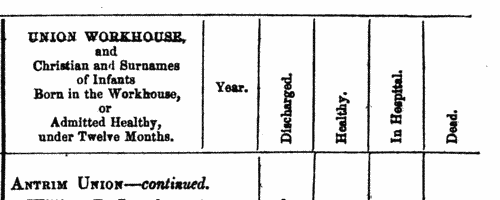
| Infants in Carlow Workhouse
(1874)
Return, “with Christian and Surname of each, of Infants Born in Irish Workhouses, or Admitted thereto when Healthy under Twelve Months Old, and attempted to be Reared therein during the Years 1872 to 1874, showing what has since become of them”. The returns from each poor law union workhouse give: Christian and Surname of Infant Born in the Workhouse, or Admitted Healthy, under Twelve Months; Year; and whether discharged, healthy, in hospital, or dead. | Sample scan, click to enlarge
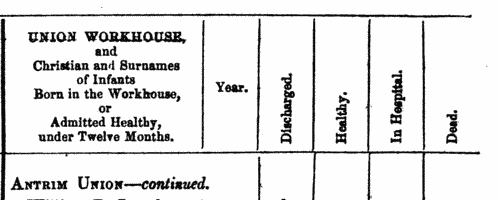
|  Outstanding soldiers of the 36th (Herefordshire) Regiment of Foot
(1870-1875) Outstanding soldiers of the 36th (Herefordshire) Regiment of Foot
(1870-1875)
Each year just a handful of outstanding soldiers of the regiment were chosen for good conduct medals and gratuities: these are listed here. There were two lists, one for men recommended for the Good Conduct Medal without a gratuity, and one for gratuities - £5 to a private, £10 to a corporal, and £15 to a serjeant. Both lists are indexed here, and each gives rank, name, regimental number, date of recommendation and date of issue. (The sample scan is from the 32nd foot). The regiment returned to England from India in 1875. | Sample scan, click to enlarge
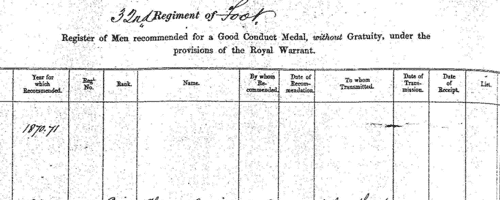
|  Outstanding soldiers of the 5th (Royal Irish) Regiment of Light Dragoons, or Lancers
(1870-1875) Outstanding soldiers of the 5th (Royal Irish) Regiment of Light Dragoons, or Lancers
(1870-1875)
Each year just a handful of outstanding soldiers of the regiment were chosen for good conduct medals and gratuities: these are listed here. There were two lists, one for men recommended for the Good Conduct Medal without a gratuity, and one for gratuities - £5 to a private, £10 to a corporal, and £15 to a serjeant. Both lists are indexed here, and each gives rank, name, regimental number, date of recommendation and date of issue. (The sample scan is from the 32nd foot) | Sample scan, click to enlarge
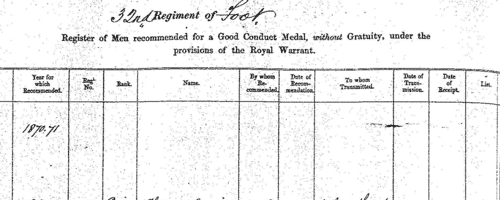
| Freeholders in county Cork
(1873-1875)
Owners of an acre or more, whether resident there or elsewhere: with their addresses; the acreage; and a valuation of the land. The survey commenced in February 1873, the last returns being received in November 1875. | Sample scan, click to enlarge
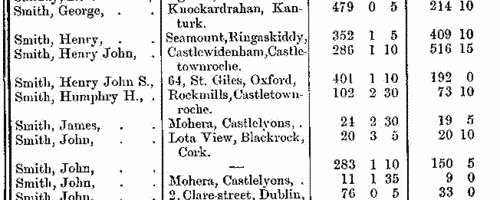
| Freeholders in county Kildare
(1873-1875)
Owners of an acre or more, whether resident there or elsewhere: with their addresses; the acreage; and a valuation of the land. The survey commenced in February 1873, the last returns being received in November 1875. | Sample scan, click to enlarge

| Freeholders in the city of Dublin
(1873-1875)
Owners of an acre or more, whether resident there or elsewhere: with their addresses; the acreage; and a valuation of the land. The survey commenced in February 1873, the last returns being received in November 1875. | Sample scan, click to enlarge

|
Research your ancestry, family history, genealogy and one-name study by direct access to original records and archives indexed by surname.
|












